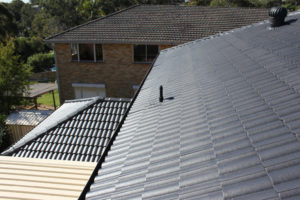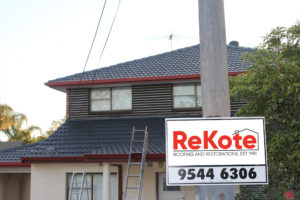Storms have been hitting Sydney homes hard, which means that many properties have been repeatedly exposed to heavy rain, hail and winds. This often translates to serious damage to roofing and sometimes structural damage to the home itself.
How to check & fix your roof after a storm
The following are roofing tips on what to look for when assessing the damage, and some of the next steps you should take. It should be noted that your safety is paramount, so you should not do anything yourself that will put you or your family in danger when taking steps to protect your home.
-
Check your gutters
One of the best places to start when assessing the damage done to your home is to check your gutters for roof debris. After a storm like the one that recently hit Sydney, it is very common for shingles and tiles to be displaced from the roof. To check for evidence of damage you may look inside gutters and drainage pipes for loose granules such as asphalt, which may have been dislodged by the storm and point to loose shingles up above. Your roof may require a professional roof cleaning.
-
Look for signs of roof damage from the ground
Another place you might find signs of roof damage is around your home. Loose shingles or broken roof parts will often be washed off the crown and down to the ground. If you find any debris on the ground, it is a strong indication that your roof might require professional repair.
-
Look for dimples on your roof
Hail or even heavy winds that bring storm debris can cause impact damage to your shingles. Sometimes, roof pieces might break off, but other times, the damage is more subtle, such as small dimples on your shingles and tiles that can grow into bigger problems down the road. Learn more about how a hail storm can affect your roof.
-
Look for signs of leaks from inside the house
Perhaps the most obvious sign of roof damage is water leaking inside the home, which should be taken care of immediately. Sometimes however leaks might be small or hidden, so you should look for secondary signs over the coming weeks and months, such as mold growing on the walls or ceiling of your home.
-
Protect your roof and belongings
Sometimes it is not possible to fix the damage you find immediately, so it might be a good idea to take steps to protect your home. If it is safe, you may use a tarp to overlay the leaking sections of your roof. However, if you find signs of structural damage, the storm hasn’t abated, or you are not confident in what you are doing, then it might be best to leave it for the professionals. If leaks penetrate the interior of your home, then take steps to move any furniture out of the way and set up towels and buckets to capture the water.
-
Call your insurance immediately
If you find that the recent storms have damaged your roof, prepare to call your insurance provider. The first step is to understand your insurance policy. Look at what is covered under your policy, what your deductibles are, how to file a claim and most importantly, your responsibilities after finding damage. Before you call your agent, it is a good idea to have a copy of your insurance policy handy, as well as photos of the damage to your roof and any household items that may have been damaged as a result.
-
Call a roofing specialist
Issues with your roof, particularly leaks, can quickly grow into serious problems if they are not taken care of immediately. If you do find signs of damage, it is important to call a roofing specialist as quickly as you can. Sometimes, it can take time to find the right supplier and book an appointment, so the earlier you start the process, the better.


